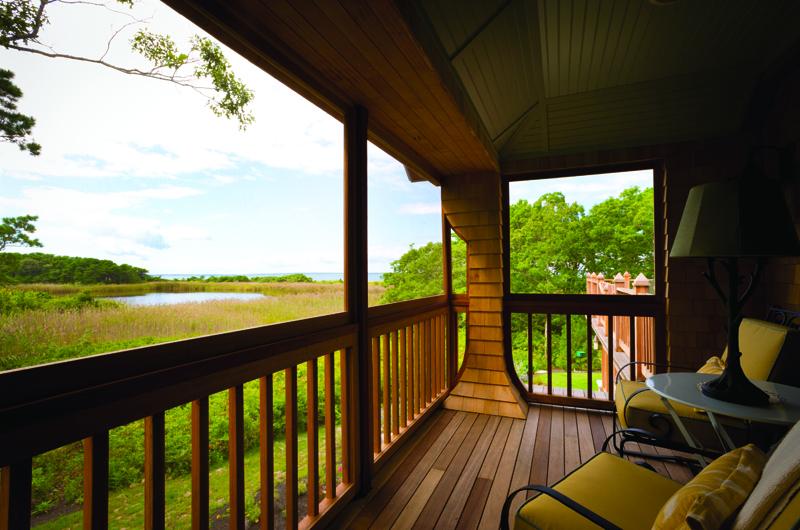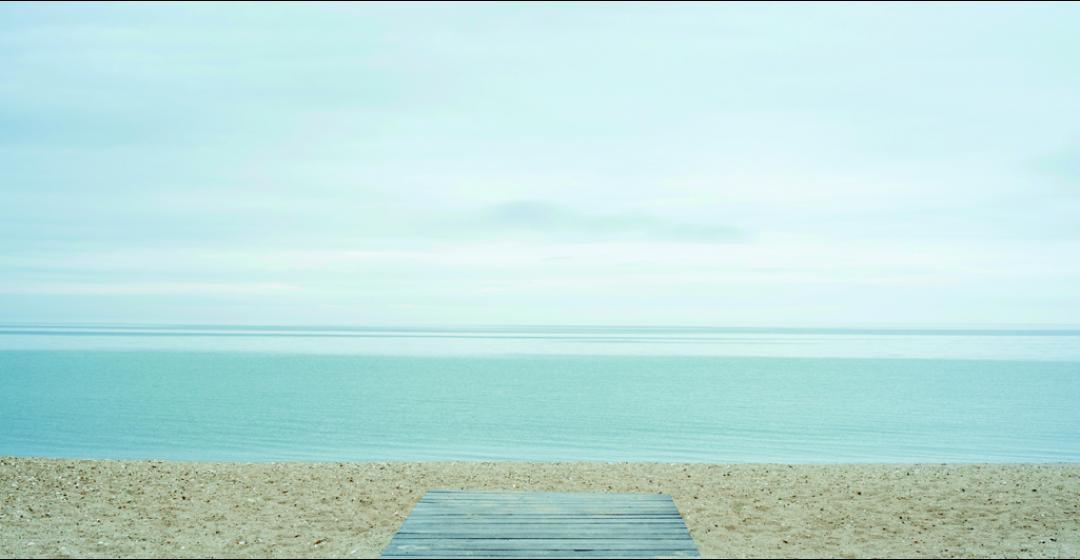Ranking the world’s top water views is an apples-and-oranges challenge of unfathomable proportions. Yet surely the Vineyard, with 125 miles of tidal shoreline and a host of great and less great inland ponds, has its contenders: the epic vistas from Chilmark hilltops, the broad sweep of ocean from the upper decks of upside-down homes in Katama, the still coves and busy town harborfronts. The list goes on and on. Without question, the Island has picturesque farms and meadows, forests and townscapes, but are they the cover models of Vineyard resort propaganda? Not so much.
What is the big deal about a water view? Swimmers, anglers, surfers, scallopers, waders, sailors – they all do something with water. But what’s special about merely looking at it? In a 2010 study entitled “Blue Space: The Importance of Water for Preference, Affect, and Restorativeness Ratings of Natural and Built Scenes,” researchers in the United Kingdom sat people in front of computer screens and exposed them to photographs of natural and built scenes. Half of the photos included “aquatic elements.” Participants rated the scenes based on, among other items, attractiveness, willingness to visit, how the view makes them feel, and willingness to pay a premium for a house or hotel room with such a view.
To no one’s amazement, the scenes with aquatic elements rated highest on all counts. And why is that? The study concluded: “Unfortunately the present research is largely descriptive and we require further research to address this question.” Sigh.
More recently, in America, turtle biologist and water lover Wallace J. Nichols applied for a Pew research fellowship to pursue his own longtime, nagging curiosity on the subject. Being a turtle scientist in the main, he summoned experts he felt were more worthy than he – neuroscientists, psychologists, real estate agents, and surfer dudes. In 2011, they gathered in San Francisco for the Blue Mind symposium, “huddling together to discuss, create, and think deeply” about the mind-water connection. So states Nichols in “Blue Mind,” published last summer. More rigorous studies followed the San Francisco meeting, and “Blue Mind” navigates a sometimes arcane world of MRIs, neuronal activity, geology, biology, human evolution, world religions, and economics. The takeaway is clear: Being in the presence of water in nature – or in swimming pools, for that matter – reduces stress. It amplifies creativity, performance, and well-being. But, alas, the “why” of it remains speculative. “The goal has been less about providing absolute answers,” Nichols concedes, “and more about asking new questions.”
Being near water may reduce stress, but reserving and paying for it, on the other hand, may have the opposite effect. “Visitors looking for lodging always ask for a water view,” says Nancy Gardella, executive director of the Martha’s Vineyard Chamber of Commerce. “Everyone wants it. Of course, once they realize the price, some people ask for places within walking distance to a water view instead.”
It’s the same on the dining scene, where freshly arrived Vineyard visitors have been known to ask for restaurant recommendations based on water views – period. It hardly matters if the clams are faithfully over-fried or if the wait staff is undertrained. Will they be able to see the water? And at eateries good or bad, how often do diners ask for a table by the window?
“One hundred percent of the time,” says Cindy Roberts, restaurant supervisor for the Harbor View Hotel. Seriously? “One hundred percent,” she repeats, “unless they see the place is obviously full.” Ditto up-Island, where savvy summer regulars at the Home Port Restaurant in Menemsha call from the hinterlands a month or more in advance of their vacations to lock in sunset reservations. The savviest of the savvy first research the timing of sundown for their date of choice to get the booking just right. When the long-awaited evening arrives, and if the weather forecast calls for gloom, they call the restaurant to cancel and plead for another reservation later in the week. Because it’s not just about the lobster. It’s the view.
Carol Shore, a vacation home rental agent for fifteen-plus years, estimates that fewer than 10 percent of tenants say that a water-view home is an absolute must-have. Perhaps that’s because a water view can add as much as seventy-five percent to the rental rate a property can command. The range? At one end of the spectrum a small, modest cottage in Oak Bluffs with a peek-a-boo view of Brush Pond goes for $1,600 per week in August. A 6,700-square-foot Edgartown home with a private beach on Nantucket Sound, not to mention the water view of the swimming pool, on the other hand, is listed for $50,000 per week with a two-week minimum.
“I think people like to wake up in the morning, look outside, and know they’re on Martha’s Vineyard rather than Anywhere, U.S.A.,” says Shore. “Some people who come from places where there are no water views would rather pay a premium for a water-view rental than to spend their vacation budget on other things.”
As it is with rentals, so it is with sales. The ideal way to grasp the added market value of a water view is to compare the sale prices of two like-kind properties – one with a view, and one without. This being the Vineyard, cookie-cutter uniformity is rare. Yet last year, two otherwise similar properties happened to be sold in the East Chop section of Oak Bluffs. Both were buildable, undeveloped lots of approximately two-thirds of an acre and within a short walk of each other. The lot where “with little careful pruning, there should be a second-floor winter water view,” according to the listing blurb, sold for $440,000. The lot with existing and proven wide-open water views over Crystal Lake and Vineyard Haven all year round sold for $825,000, or nearly double.
“Blue means green,” an Island real estate broker once explained to Tom Robinson, a certified arborist whose company, Island Timber, owes about a third of its business to “view jobs.”
How does one determine the market value of a particular water view? Of course, the answers are all in the eye of the beholder. But some beholders are more equal than others and inspect properties on behalf of the Island’s tax assessors. Interestingly, there are some indications that water views are gradually trumping even water frontage in adding value, especially in recent years as flood insurance hikes and cliff erosion increasingly worry the marketplace. Beyond that, this being the Vineyard, each town has its own way of, well, viewing things. Oak Bluffs doesn’t necessarily make notations about water views in their property records. Aquinnah, Chilmark, and Tisbury, on the other hand, are darn near scientific about applying so-called “water factors” – view, frontage, and/or access and the quality thereof – into a property valuation.
In Tisbury, for example, an inspector may assign a property a “water factor” on a scale of one to five, i.e., from “Not So Much” to “OMG.” The assessor then feeds that water factor into a formula that could wrinkle Einstein’s brow in order to compute the overall property valuation. One waterfront property on West Chop has a water factor of 5.0, while another property, near the tip of Hines Point, with Lagoon Pond frontage and views both east and west, rates a mere 2.75. Why the discrepancy? According to Tisbury Assistant Assessor Ann Marie Cywinski, views of ponds and lakes are invariably given a lower “water factor” value than ocean views.
“It’s completely subjective,” says Cywinski. “Water factors for a given property are based solely on an inspector’s personal judgment.”
Only the town of West Tisbury adamantly eschews the “w” word in property valuations. “The state Department of Revenue doesn’t like the use of water factors,” says town assessor Dawn Barnes. “Therefore, we don’t say we have a water view tax. We have a desirability-of-location tax.” And what are the most desirable West Tisbury locations? “The South Shore, the Great Ponds, and Makonikey,” says Barnes.
Locations which just happen to have, you guessed it, water views.

If a tree falls in winter…Have your permission in writing
Views on the Vineyard can come and go, often in far less time than an archeological age. In 1973, during the height of the Vineyard subdivision craze, a development was created in the hills of West Tisbury’s Lambert’s Cove and named Longview for the distant water vistas from the higher elevations. Forty years on, the westward facing decks of many original Longview homes have long views of towering tree canopies. Their long views of the water are long gone.
“Almost all the trees on the Vineyard still have growing potential,” says arborist Tom Robinson of Island Timber, noting that the Island’s mature oaks and pines grow six inches to a foot per year. “When they get older, they just grow more slowly or die.”
Some customers have their views trimmed on a yearly basis, a little bit at a time, but a rotation of three to five years is generally more cost effective. “The frequency depends on several things: how flat the view angle is from the property to the water, what kind of tree it is, and how fast new growth appears.” Another factor is the species of tree: pines generally can’t recover from toppings as well as the Island’s deciduous oaks, cherries, or beetlebungs can.
Before the chainsaw starts up, it’s usually easy to confirm that a subject tree is within one’s own property lines by foraging for marked bounds or reviewing plot plans. But if the tree that’s blocking the view is, say, hundreds of yards in the distance, it can be a bit of a crap shoot to find it on the ground. In those cases Robinson has someone throw a rope high into the branches of a tree that might be “it” and then give it a shake, while someone else at the client’s home keeps an eye out for the jiggling arbor.
“Get it in writing,” he says about obtaining permission before removing foliage on other people’s property. This also goes for publicly owned lands, and any land within one hundred feet of wetlands and salt marshes.
“I take a hard line with anyone who cuts without a permit,” says Liz Durkee, conservation agent for the town of Oak Bluffs. “Vegetation is so critical for protecting our dunes and beaches. It provides food and shelter for wildlife. The root systems help filter pollutants that would otherwise go into our ponds.” Should the conservation benefits fail to impress homeowners who are dead set on clear-cutting, they should be further advised that vegetation also mitigates flooding and land erosion and thus protects their house.
Conservation committees do have a heart, however. Some Island towns will grant special permits for clearing narrow view channels even through native plants. In Oak Bluffs, for instance, the clearing allowance can range from approximately two to fifteen degrees – “whatever the commissioners feel is most logical for the size of a given property,” says Durkee. “It’s kind of subjective.” If the view is blocked by invasive phragmites – those ubiquitous blond grasses with the feathery tops that grow tall enough to block a vista from the vantage point of a lounge chair on a low deck ---– the ConCom will all but bet you to clear as much as you care to try.





